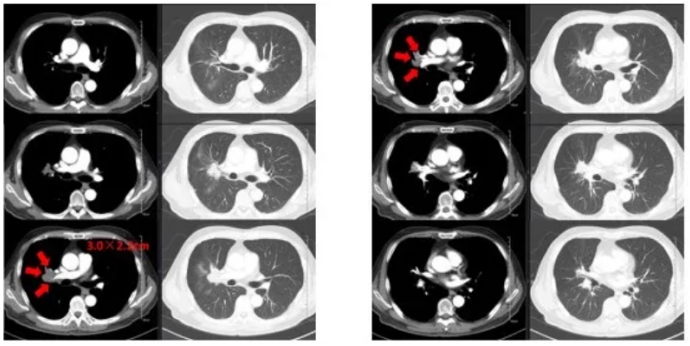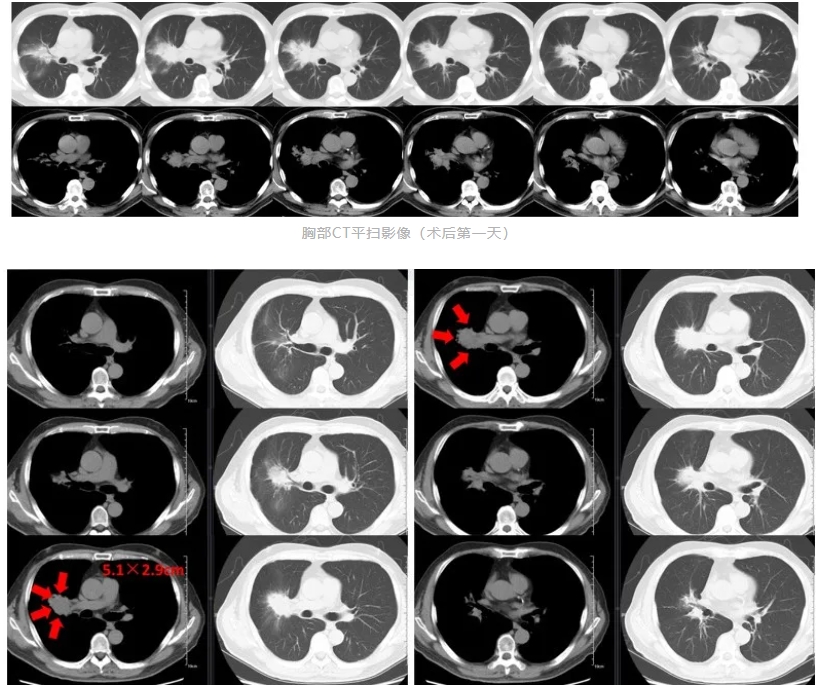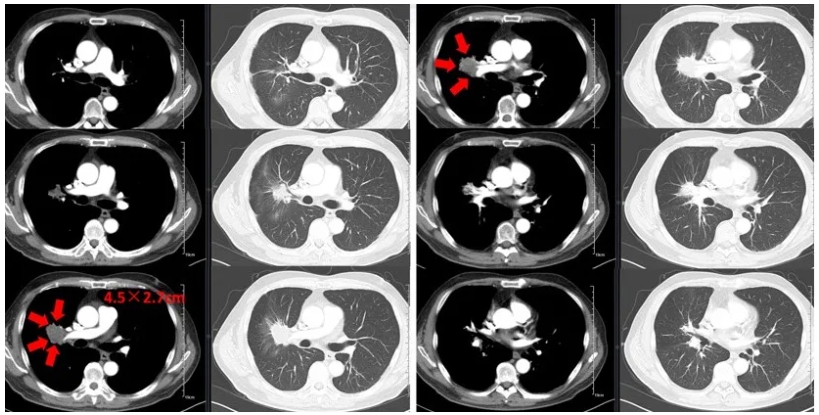Summary: The article shared a typical case of percutaneous puncture treatment for right lung metastasis of colorectal cancer with Cryosurgical System. Professor Li Xiaoguang of Beijing Hospital commented on the case.
Basic information: Mr. He, male, 66 years old, was admitted to the hospital on Day 18 after it was found that the metastatic lesions in the hilum of the right lung increased. He received colorectal cancer surgery more than 4 years ago. He had “diabetes” for more than 30 years and controlled this condition by taking metformin and sitagliptin orally. He also suffered from “hyperlipidemia” for more than 1 year and took pravastatin orally to reduce the blood lipid level.
Chest Enhanced CT: Lesions were observed in the upper hilum of the right lung, and there were irregular consolidation shadows in the upper and middle lobes of the right lung near the hilum, with a larger cross section of approximately 3.0 × 2.2 cm, which were slightly larger than before.
Pathological examination: (Left hemi-colon) Ulcerative adenocarcinoma, moderately differentiated, without cancer metastasis in mesenteric lymph nodes (0/28).
Previous treatment history: Radical resection of colon cancer, PT3N0M0 → M1 IV stage; chemotherapy for lung metastasis combined with targeted therapy; microwave ablation for metastatic tumors in the upper lobe of the right lung; radiotherapy for prostate cancer and radiotherapy for metastatic cancer in the hilum of the right lung, partial recrudescence of the metastatic lung cancer.
Clinical diagnosis: Colorectal cancer, metastatic lung cancer and prostate cancer.
Regimens: Upon discussion with MDT, perform the co-ablation with Cryosurgical System.
Routine examination showed that there were no abnormalities in coagulation function and tumor indexes.
DD 0.091 mg/L
PT 10.2S
APTT 28.8 s
TT 13 s
HGB 157 g/L
GLU 5.3 mol/L
TP 67 g/L
CRE 90 umol/L
URIC 322 umol/L
CEA 3.1 ng/ml
AFP 2.4 ng/ml
CA125 9.9 U/ml
CA 153 5.4 U/ml
CA 199 6.4 U/ml

Chest Enhanced CT Images: Right Upper Hilum Lesions, with a Cross Section of about 3.0 × 2.2 cm
Co-ablation regimen with Cryosurgical System: The patient was in a supine position, and 1 probe was arranged.
Characteristics of intraoperative ablation: The lesions were adjacent to the lung hilum, which was prone to hemoptysis. Cryosurgical System could reduce the risk of hemorrhage.

(Left: Patient Posture and Device Placement; Right: In-vitro Photo of Needle Arrangement)
Co-ablation with Cryosurgical System:
4 cycles;
Cycle 1: Freeze for 10 min and rewarm for 2 min;
Cycle 2: Freeze for 5 min and rewarm for 2 min;
Cycle 3: Freeze for 8 min and rewarm for 5 min;
Cycle 4: Freeze for 15 min and rewarm for 3 min;

(Line 1, top left: Cycle 1; Line 1, top right: Cycle 2; Line 2: Cycle 3; Line 3: Cycle 4)

Chest CT Plain Scan Images (one month after the surgery)

Chest CT Plain Scan Images (three months after the surgery)
The patient He XX received radical resection of colon cancer, chemotherapy for lung metastasis combined with targeted therapy, microwave ablation for metastatic tumors in the upper lobe of the right lung, radiotherapy for prostate cancer and radiotherapy for metastatic cancer in the right lung hilum, and suffered from partial recrudescence of the metastatic lung cancer.
Upon MDT discussion, the right lung metastasis was treated with percutaneous puncture by co-ablation with Cryosurgical System. The 1-needle and 4-cycle regimen was selected during the surgery, and the surgery was successful.
The CT re-scan immediately after the surgery showed that the ablation scope covered the lesions completely, and no complications such as hemoptysis and pneumothorax occurred.
On the first day after the surgery, the CT re-scan showed no hemorrhage or pneumothorax. The patient recovered well after the surgery and was discharged immediately.
The reexamination 1 and 3 months after the surgery showed that the local lesions decreased, and the tumor completely resolved.
Efficacy evaluation: The local control effect of the patient was good, and the therapeutic goal was achieved; the quality of life was effectively improved. The patient had a lesion in the lung hilum, with a high probability of massive hemoptysis. Co-ablation with Cryosurgical System greatly reduced the risk of hemorrhage.
Device use experience: During the treatment with the Cryosurgical System, the temperature could rise and drop quickly, the ice ball formed quickly, the ablation scope of a single needle was big with well safety.
Comments from experts:
Evaluation of the regimen: This case was a typical case of percutaneous puncture treatment for right lung metastasis of colorectal cancer with Cryosurgical System. After multi-line treatments, the patient’s right hilum metastasis was not well controlled, but the local tumor activity was effectively controlled after Cryosurgical System co-ablation, and no complications occurred after the surgery. The regimen for this case was reasonable in design, and the treatment effects were satisfactory, which effectively improved the patient's survival time and ensure the patient’s quality of life.
Comments on Cryosurgical System: The co-ablation with Cryosurgical System was safe and effective as a local treatment method for tumors, especially for tumors near tissues and organs and other dangerous sites, it had incomparable advantages compared with other local treatment methods, and the patient was well tolerance to the treatment, which further increased the compliance of the patients’ treatment. In addition, cryoablation can activate the anti-tumor immune mechanism of the body. The collaborative system therapy represents a new hope for the survival of the patient with advanced solid tumors.
Surgeon: Professor Guo Runqi, skilled at ablation, the annual number of operations is more than 200 cases.
Surgical team: Professor Li Xiaoguang’s team, the cancer minimally invasive treatment center of Beijing Hospital. (The cancer minimally invasive treatment center of Beijing Hospital has 20 beds now, with an average annual ablation surgery of 600 cases.)
Professor Guo Runqi, graduated from Peking University in surgery (earned a Professional doctor’s degree).
From 2018 to now, he has served as a resident and attending physician in Beijing Hospital.
Member of the Physics Expert Committee of the Particleology Group of the Minimally Invasive Tumor Treatment Professional Committee of China Anti-Cancer Association
Member of the Thyroid Specialist Committee of Chinese Primary Health Care Foundation.
As the first author/co-author, he has published more than 20 articles in SCI and has been invited to participate in the annual meeting of AUA and EAU for many times to conduct the wall newspaper show and speak at the meeting.
He has participated in the special project of medical development and scientific research in the capital, the special project with clinical characteristics in the capital and the national key special research and development plan. He has also undertaken the in-hospital project and the basic scientific research business expense project of the central college in the Peking Union Medical College.
Professor Li Xiaoguang
Director of minimally invasive tumor treatment center and director of radiology department of Beijing Hospital
Chief physician, professor and doctoral supervisor
Vice chairman of the Minimally Invasive Tumor Treatment Committee of China Anti-Cancer Association
Chairman designate of the Interventional Medicine Branch of Beijing Medical Association
Vice chairman of the Interventional Physician Branch of Beijing Medical Doctor Association
Vice chairman of the Tumor Interventional Committee of Chinese Research Hospital Association
Vice chairman of the Interventional Diagnosis and Treatment Branch of China International Exchange and Promotive Association for Medical and Health Care.
Professor Li Xiaoguang is skilled at the Cryosurgical System co-ablation of tumors in all parts of the body, especially for lung cancer, breast cancer, liver cancer and prostate cancer, etc.
 Hygea Medical Technology Co., Ltd.
Hygea Medical Technology Co., Ltd.